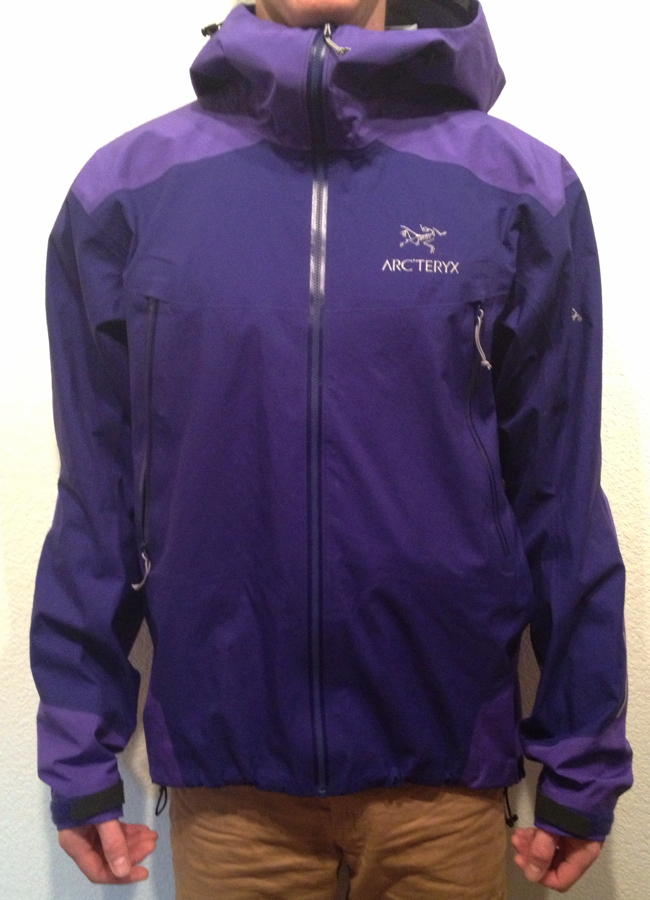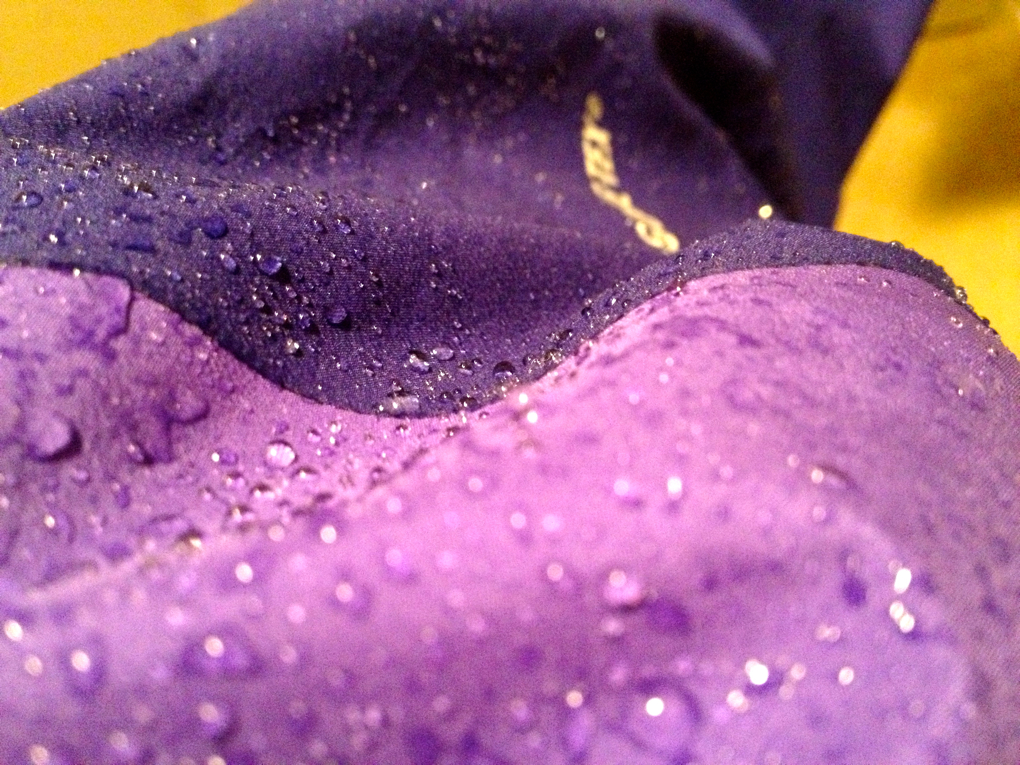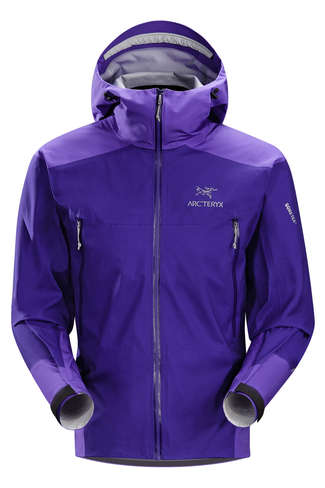“Breathable” Hard Shells
There are thousands of technical jackets on the market today, and we’ve singled out three of them: the Arc’teryx Beta FL, the Westcomb Switch LT Hoody, and the Rab Viper.
What makes these jackets worthy of being singled out is that each of them uses a new membrane technology that is cutting edge in its ability to increase breathability.
These jackets use three different membrane technologies to keep you warm and dry.
1) Gore-Tex Active (in the Arcteryx Beta FL) is Gore’s best performing membrane in the realm of breathability. By integrating the tricot backer with the PU protective layer on the ePTFE membrane, Gore shortens the diffusion path of your sweat, resulting in better breathability than standard Gore fabrics.
2) Polartec NeoShell (in the Westcomb Switch LT Hoody) is part of a new class of waterproof breathable (WPB) membranes that actually allow a minute (and imperceptible to the wearer) amount of air to pass through, which greatly enhances breathability. This technology is air permeability, or air perm for short.
3) eVent DV Lite (in the Rab Viper) is also an air perm fabric. DVL is a 2.5L layer fabric which means that there is no tricot liner, just a printed scrim to protect the membrane.
I’ll be focusing mainly on the real world performance of these jackets in these reviews, but for a much more thorough rundown of outerwear and membrane technology, check out my Outerwear 101 and Outerwear 201 articles. I strongly recommend reading those articles in conjunction with this review.
For each of the jackets I’ve tested, I will give a general rundown on the 3 F’s: Fit, Features, and Fabric. At the end of the piece I will draw more direct comparisons (and give a few highly subjective opinions) between each jacket.
Keepin’ It Real: Hard Shells & Breathability
One of the most important things I realized while testing these ‘super breathable’ hard shells is that any hard shell, no matter how breathable it is claimed to be, is still a huge vapor barrier.
So in order to get a truly substantial jump in breathability, you have to go to a soft shell.
Are the jackets tested here some of the most breathable hardshells on the market? Yes. Do they breathe like a soft shell? No.
You buy hardshells because they offer the highest level of protection from the elements. And you must be willing to sacrifice some breathability for that added protection.
Now that we’re clear, we’ll get this review series started with the Arc’teryx Beta FL.
Arc’teryx Beta FL
Size: Medium
Weight: 322g
MSRP: $450
Fabric: Gore-Tex Active Shell
MATERIALS
- Membrane/Laminate: N30p-X GORE-TEX® Active 3L
- Reinforced Areas: N40p-X GORE-TEX® Active 3L
Technical Features
- Waterproof
- Highly breathable—maintains comfort during aerobic activity
- Lightweight
- Compressible and packable
Construction
- Laminated high-strength hanger loop
- GORE-TEX® three-layer construction
- Tiny GORE® seam tape (13 mm)
- Micro-seam allowance (1.6 mm) reduces bulk and weight
- Articulated elbows
Hood Configuration
- Laminated brim
- Adjustable hood drawcords
- Storm Hood™
Collar Configuration
- Soft brushed-lined collar
Zippers & Fly Configuration
- WaterTight™ Vislon front zip
Cuff & Sleeves Configuration
- Laminated die-cut Velcro® cuff adjusters reduce bulk, and won’t catch or tear off
Hem Configuration
- Drop back hem
- Adjustable hem drawcord
- Laminated hem
Pocket Configuration
- Two hand pockets with WaterTight™ zippers
- Included mini stuff sack with drawcord closure
Logos & Label Configuration
- Reflective blazes for enhanced visibility in low light
Days worn: ~15
The Arcteryx Beta FL is a lightweight jacket designed with the light and fast mentality required for large objectives in the high alpine. The Beta FL is a minimalist jacket made from Gore’s lightweight Active Shell fabric, has a very minimal feature list, and a super lightweight, 4mm, YKK Aquaguard placket-less main zip.
Although marketed for ski touring, I’d be inclined to situate this jacket as more of a 3+ season weather protection piece rather than as a winter hardshell, because it is so stripped down and lightweight. For comparison, I would consider a piece like The North Face Enzo a winter hardshell because it has a heavier shell fabric and a full-function powder skirt.
The Beta FL is instead much more versatile in the spring/summer/fall because of its low weight and its non discipline-specific feature set.
Fit
In my opinion, the fit of the Arc’teryx Beta FL is its best feature. Arcteryx has been making jackets for a very long time, and their fits have always been done well. The Beta FL is no exception.

The Beta FL is a very form-fitting jacket, and is slightly slimmer than the Westcomb Switch LT Hoody, and definitely slimmer than the Rab Viper. It is slim enough to avoid unnecessary bulk, but still has enough room to layer.
For my thin 5’10” frame, the medium hugs me well, while still providing enough room for even my Montbell Alpine Light down jacket (though the insulation gets a bit compressed in the arms). My Patagonia Nano Puff fits easily underneath.
The Beta FL is cut with a generous drop hem (it’s longer than the Westcomb Switch LT’s), which is great for hanging out around camp when you are sitting on potentially wet things. It is also very functional for riding bikes, as the back dips plenty low to cover that pant/shirt seam while riding.
The arms are cut anatomically and have great range of motion, while the 3-way adjustable hood is large enough to put over a climbing helmet (though it can easily be adjusted to be used without one).
Fabric
Gore-Tex Active Shell is Gore’s most breathable lamination. The increased breathability is achieved through a high pressure and temperature lamination process, where the tricot liner is bonded to the ePTFE/PU membrane. (For more information on WPB membranes, check out my Outerwear 101 and Outerwear 201 articles.) This makes the diffusion path required for water vapor to escape the membrane significantly shorter, which increases breathability.
Gore-Tex Active Shell is not an air permeable, though, and that is very important to note. It still features a monolithic PU laminate that eliminates any and all air flow through the membrane.
In the mountains, the Beta FL’s fabric has proven quite durable. Although it is fairly lightweight for a 3L fabric, it has been quite rugged throughout my testing. There is no visible wear on the shoulders or seat – the two areas that receive the heaviest wear.
The Arc’teryx Beta FL has gotten me through some pretty rough weather as well, including high winds, heavy snow, and wind-driven rain. Overall, I have been very pleased with the wet weather performance of the jacket. In heavy rain, there is some soak through of the DWR on the shoulders and arms—typically these areas are the first place where the DWR wears out—but of the three jackets tested in this review, the Gore fabric had the most soak through.
That’s not to say, however, that soak through is an issue with any of the three jackets in this test. Where I experienced zero soak through on the Westcomb or Rab jackets, I experienced a small amount in the Arcteryx.

Water soaking through the DWR will only make the jacket feel heavier and will slightly reduce breathability. It will not affect whether or not you get wet. In heavy snow (including some delightful graupel in the Cascades) the Beta FL performed well and lived up easily to Gore’s 100% waterproof guarantee.
In very high winds (40+ mph gusts) I sometimes felt air getting through the main zipper, and while it was not bad enough to cause me significant concern, it does point to why Westcomb opted to install an inner placket behind their similar, main zipper on their Switch LT Hoody.
NEXT PAGE: Breathability

